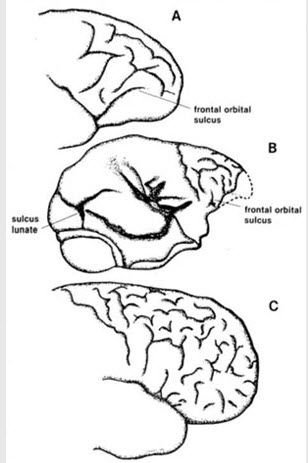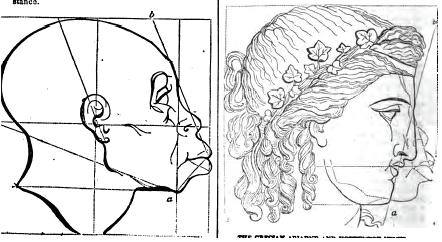JOURNAL - 2012
040212 CEREBRAL CONVOLUTIONS
CEREBRAL CONVOLUTIONS OF THE NEGRO BRAIN - Dr. A. J. Parker remarked that as yet our knowledge of the cerebral convolutions in the various races is very scanty. Gratiolet, Marshall, and a few other investigators, have published descriptions of single brains, and have pointed out certain peculiarities existing in them. Beyond this, however, little has been done, and the object of the present communication is to direct attention to some of the principal points noticed in the study of thirteen negro brains, and one mullatto.





Gratiolet, in his studies of the brain of the Hottentot Venus, noticed that in the normal position of the brain, the island of Reil was distinctly visible. Marshall afterwards found the same peculiarity in the brain of a Bush woman, and suggests the probability that is characteristic of the Bosjes brain; citing the opinion of G. Cuvier that the Hottentot Venus was really a Bushwoman, and not a Hottentot. In studying the negro brain as it presents itself in this country, Dr. Parker had found the same condition well marked in nine cases, and perceptible in the remaining four. It would thus seem to be characteristic of the race rather of the Bosjes alone. In the brain of a mulatto, the convolutions of which were exceedingly well developed, the same peculiarity was found, although not to so marked an extent as in the negro. Since it is thus capable of being transmitted when the race is crossed with another; it would appear to be a definite and strongly marked peculiarity. Although this condition of the negro brain is foetal in its character, as was noted by Gratiolet and Marshall, it is not found in the adult brain of any monkey thus far described.

The Sylvian fissure, also, presents certain characteristics. In the white, this fissure ascends obliquely upwards and backwards. In the Bushwoman, Marshall found that it assumed at its anterior portion a horizonal direction, the posterior portion taking a direction nearly perpedicular to this. He also points out the same peculiarity in the figure given by Gratiolet of the Hottentot Venus. This peculiarity of the Sylvian fissure was also found in the negro brains which Dr. Parker had studied. In the mulatto it presented the same appearances as in the white brain. The length of the Sylvian fissure also varies, as was noted by Marshall in the brain of the Bushwoman.
Average length of Sylvian fissure in 19 white brains = 3 5/8 in.
Average length of Sylvian fissure in 13 negro brains = 3 in.
Length of Sylvian fissure in mulatto = 3 1/4 in.
The frontal convolutions, as a rule, are simpler and better marked in the negro than in the white. Gratiolet states that in the European the lower frontal convolution is the most clearly defined, while the upper and middle more often run into each other. In the Bushman, he says, on the contrary, the upper remains independent, while the middle and lower blend. In the negro brains of this country this does not seem to be the case -- at least in those which had been examined, the lower frontal convolution seemed to be as well defined as in the upper.
The fissure of Rolando, or central fissure, is simpler, straighter, and less undulating in its course in the negro than in the white, and, consequently, the anterior and posterior central convolutions partake of the same character.
The interparietal fissure is present in the apes as a distinctly marked typical fissure, but in man, as exemplified by the white race, it is so broken up by bridging convolutions that its existence as a distinct fissure was not recognized until 1866, when its typical character was first pointed out by Turner, who gave to it the above name. It has been recognized as an important and typical fissure only by Pansch and Ecker. Bischoff states that it is present in the foetus, and is typical; but that in the adult brain it does not present the characters given to it by Turner.
In Dr. Parker's studies of the white brain he had always been able to clearly distinguish this fissure. It is generally interrupted in its course by two or three bridging convolutions. In the negro, however, this fissure was found remarkably well developed, and much less tortuous than in the white. In five instances it was found entirely distinct, and not bridged over at any point, presenting in every respect the same appearance as found in the higher apes, except that its direction was more curved than in the latter. In six cases only one bridging convolution existed, and, in the remaining two, one well developed and another imperfectly developed were found. In the mulatto this fissure was continuous throughout its course, but much more undulating and tortuous than in the negro. A study of negro brains shows a distinctly ape-like character in regard to this fissure, and at the same time would seem to prove that it is present in the adult human brain as in a perfectly typical fissure.
The superior and inferior parietal convolutions are simpler and less marked with secondary fissures in the negro than in the white. The anterior division of the inferior parietal convolution which lies between the lower end of the posterior central convolution and the upper end of the fissure of Sylvius, the supra-marginal lobule of Gratiolet, was described by him as peculiar to the human brain. It is, however, represented in the brain of the apes, although not expanded and developed into a lobule, as it is in man. A careful study of the negro brains at his disposal, had shown that even this excess of development is not absolutely characteristic of the human brain. In one negro brain the photograph of which was presented, this lobule is entirely absent, the brain showing a deficiency in this region greater in proportion than is found in the apes. The interparietal fissure runs directly into the upper end of the Sylvian, their place of union being directly back of the posterior central convolution; consequently there is absolutely no supra-marginal lobule developed. In the brain of the Bush woman described by Marshall this lobule was present, relatively well developed, although smaller, according to this author, than is found in the European. It was marked by several secondary sulci. It was, however, better developed than in the Hottentot Venus, being larger, more complex, and projecting to a greater extent over the Sylvian fissure. In the brain above described it was, therefore, more ape-like than in either the Bush woman or Hottentot Venus. In the remaining negro brains examined, this lobule presented itself in variously developed conditions. In two cases ti was small, and not marked by any secondary fissures. The remaining brains approached more towards the condition as found in the white race, but were all less complex and smaller than is the case in the latter. In the mulatto it was as well developed as is ordinarily found in the white.
He then passed to the consideration of the occipital lobe, and here the negro brain displays its ape-like peculiarities to a greater extent than in any other portion of the cerebral surface. This lobe, as it is found represented in the apes, is comparatively simple. It is separated from the parietal lobe by a well-marked transverse fissure, the so-called perpendicular fissure; the mesial portion, corresponding to a fissure known in the human brain as the parieto-occipital, is called the internal perpendicular, while the lateral portion is known as the external perpendicular fissure. In most of the monkeys, such as Cebus, Cynocephalus, Cercopithecus, Macacus, etc., these two fissures are continuous; but in man and the higher apes, such as the Orang, Chimpanzee, etc., they are separated into two distinct fissures by the development of a bridging convlution, the so-called superior external transition or connecting convolution, the pli de passage superieur externe of Gratiolet. The same condition is also found in Ateles and Hylobates. In man this convolution is largely developed, and alters, to a great extent, the appearance of this region as found in the apes. This convolution he had found invariably smaller, less developed, and simper in the negro than in the white. In one negro brain it was so imperfectly developed that the internal and external perpendicular fissures were superficially continuous. The fissure corresponding to the external perpendicular is also better developed in the negro.
It has been asserted that the separation of the parieto-occipital fissure on the mesial surface from the calcarine, by means of the lower internal connecting convolution (pli de passage inferieur interne, Gr.) is characteristic of the ape as distinguished from the human brain. Huxley has shown, however, that in the brain of Ateles paniscus the parieto-occipital and calcarine join each other; and Bischoff has remarked the same circumstance as existing in Hybolates. In all other monkeys and apes, as far as present observation extends, the pareito-occipital is separated from the calcarine by this convolution. Bischoff states that this convolution is always present in man, but is deeply sunk within the depths of the parieto-occipital fissure. Ecker also describes this as represented in man as a deeply concealed convolution under the name of gyrus cunei. That this entering of the parieto-occipital into the calcarine is not a chacracteristic always found in the brain of mans was shown by the photograph of a negro brain, which showed this convolution as well developed as it is in the apes, presenting a width of nearly one-quarter inch superficially, and separating completly the parieto-occipital from the calcarine. This is the first huyman brain in which this complete separation has been pointed out. It is the mesial survace of the same brain in which was noticed the complete absence of the supra-marginal lobule, and these two points, and the large and simply marked occipital lobes, in connection with numerous other points, stamps this brains the most ape-like of human brains yet described. It is the brain of an adult male negro about twenty-two years old. In another case the same condition was found, only less developed. It is an interesting fact, that these ape-like peculiarities occurred almost entirely on the right side of the brain, the left hemisphere resembling more nearly the white brain than the right. In the negro it would also appear that there is less departure from symmetry on the two sides of the brain than in the white.
Gratiolet states that the simplicity of the brain of the Hottentot Venus is more marked than in any normal European brain he has seen, and Marshall expresses the same opinion in respect to the brain of the Bush woman. Dr. Parker's experience in studying the negro brain as it presents itself in this country had let him to the same conclusion, and he believed that the negro brain bears an unmistakably nearer relation to the ape type than does the white. It is interesting to note that in just those peculiarities which have been thought to distinguish the human brain from that of the ape, the negro brain presents itself as offering noteworthy exceptions; for instance, the absence of the supramarginal lobule or its imperfect development, the presence of the inferior internal connecting or bridging convolution visible superficially, and completely separating the parieto-occipital from the calcarine, etc.
Published by the Academy of Natural Sciences of Philadelpha, Vol 30, 1878
Proceedings of the Academy of Natural Sciences of Philadelphia

